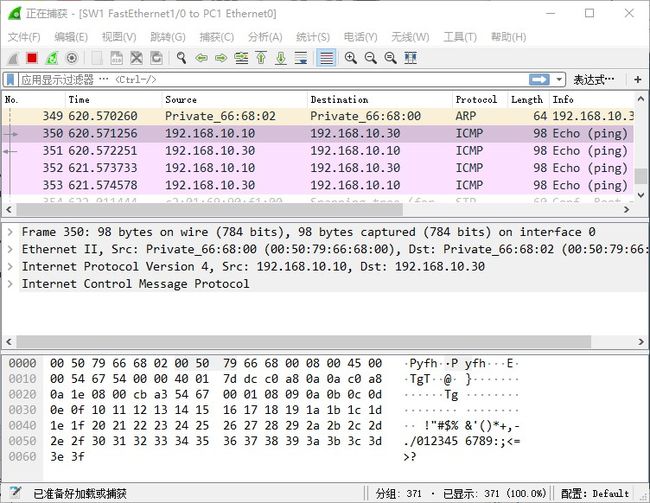当网络中有多台交换机时,位于不同交换机上的相同VLAN的主机之间时如何通信的呢?我们使用Trunk实现跨交换机VLAN通信。还有以太网通道的操作哦。
实验拓扑
两台交换机直连,每台下面再连接两台VPC,划分VLAN,地址规划如下:
| 名称 | 接口 | VLAN | 地址 |
|---|---|---|---|
| PC1 | SW1-f1/0 | vlan 10 | 192.168.10.10/24 |
| PC2 | SW1-f1/1 | vlan 20 | 192.168.10.20/24 |
| PC3 | SW2-f1/0 | vlan 10 | 192.168.10.30/24 |
| PC4 | SW2-f1/1 | vlan 20 | 192.168.10.40/24 |
配置方法
SW1(config)#interface fastEthernet 1/2
SW1(config-if)#switchport mode trunk
SW1(config-if)#switchport trunk encapsulation dot1q
SW1(config-if)#end配置过程
交换机划分 VLAN
- SW1
SW1#conf t
SW1(config)#no ip routing
SW1(config)#vlan 10,20
SW1(config-vlan)#ex
SW1(config)#int f1/0
SW1(config-if)#sw m a
SW1(config-if)#sw a v 10
SW1(config-if)#ex
SW1(config)#int f1/1
SW1(config-if)#sw m a
SW1(config-if)#sw a v 20
SW1(config-if)#ex
SW1(config)#do show vlan-sw b
VLAN Name Status Ports
---- -------------------------------- --------- -------------------------------
1 default active Fa1/2, Fa1/3, Fa1/4, Fa1/5
Fa1/6, Fa1/7, Fa1/8, Fa1/9
Fa1/10, Fa1/11, Fa1/12, Fa1/13
Fa1/14, Fa1/15
10 VLAN0010 active Fa1/0
20 VLAN0020 active Fa1/1
1002 fddi-default act/unsup
1003 token-ring-default act/unsup
1004 fddinet-default act/unsup
1005 trnet-default act/unsup- SW2
SW2#conf t
SW2(config)#no ip routing
SW2(config)#vlan 10,20
SW2(config-vlan)#ex
SW2(config)#int f1/0
SW2(config-if)#sw m a
SW2(config-if)#sw a v 10
SW2(config-if)#ex
SW2(config)#int f1/1
SW2(config-if)#sw m a
SW2(config-if)#sw a v 20
SW2(config-if)#ex
SW2(config)#do show vlan-sw b
VLAN Name Status Ports
---- -------------------------------- --------- -------------------------------
1 default active Fa1/2, Fa1/3, Fa1/4, Fa1/5
Fa1/6, Fa1/7, Fa1/8, Fa1/9
Fa1/10, Fa1/11, Fa1/12, Fa1/13
Fa1/14, Fa1/15
10 VLAN0010 active Fa1/0
20 VLAN0020 active Fa1/1
1002 fddi-default act/unsup
1003 token-ring-default act/unsup
1004 fddinet-default act/unsup
1005 trnet-default act/unsup配置 Trunk
- SW1
SW1(config)#interface fastEthernet 1/2
SW1(config-if)#switchport mode trunk
SW1(config-if)#switchport trunk encapsulation dot1q
SW1(config-if)#end- 查询验证
SW1#show interfaces fastEthernet 1/2 switchport
Name: Fa1/2
Switchport: Enabled
Administrative Mode: trunk
Operational Mode: trunk
Administrative Trunking Encapsulation: dot1q
Operational Trunking Encapsulation: dot1q
Negotiation of Trunking: Disabled
Access Mode VLAN: 0 ((Inactive))
Trunking Native Mode VLAN: 1 (default)
Trunking VLANs Enabled: ALL
Trunking VLANs Active: 1,10,20
Protected: false
Priority for untagged frames: 0
Override vlan tag priority: FALSE
Voice VLAN: none
Appliance trust: none- SW2
SW2(config)#int f1/2
SW2(config-if)#sw m t
SW2(config-if)#sw t e d
SW2(config-if)#do show int f1/2 switchport
Name: Fa1/2
Switchport: Enabled
Administrative Mode: trunk
Operational Mode: trunk
Administrative Trunking Encapsulation: dot1q
Operational Trunking Encapsulation: dot1q
Negotiation of Trunking: Disabled
Access Mode VLAN: 0 ((Inactive))
Trunking Native Mode VLAN: 1 (default)
Trunking VLANs Enabled: ALL
Trunking VLANs Active: 1,10,20
Protected: false
Priority for untagged frames: 0
Override vlan tag priority: FALSE
Voice VLAN: none
Appliance trust: nonePING 测试
- PC1
PC1> ip 192.168.10.10
Checking for duplicate address...
PC1 : 192.168.10.10 255.255.255.0
PC1> ping 192.168.10.20
host (192.168.10.20) not reachable
PC1> ping 192.168.10.30
84 bytes from 192.168.10.30 icmp_seq=1 ttl=64 time=1.876 ms
84 bytes from 192.168.10.30 icmp_seq=2 ttl=64 time=1.853 ms
84 bytes from 192.168.10.30 icmp_seq=3 ttl=64 time=1.992 ms
84 bytes from 192.168.10.30 icmp_seq=4 ttl=64 time=0.000 ms
84 bytes from 192.168.10.30 icmp_seq=5 ttl=64 time=1.853 ms
PC1> ping 192.168.10.40
host (192.168.10.40) not reachablePC1 PING PC3 抓包
- 在
SW1的F1/0接口开启抓包
- 在
SW1的F1/2接口开启抓包
数据包在出交换机时被打上
vlan 10的标签。
- PC2
PC2> ip 192.168.10.20
Checking for duplicate address...
PC1 : 192.168.10.20 255.255.255.0
PC2> ping 192.168.10.10
host (192.168.10.10) not reachable
PC2> ping 192.168.10.30
host (192.168.10.30) not reachable
PC2> ping 192.168.10.40
84 bytes from 192.168.10.40 icmp_seq=1 ttl=64 time=1.992 ms
84 bytes from 192.168.10.40 icmp_seq=2 ttl=64 time=1.999 ms
84 bytes from 192.168.10.40 icmp_seq=3 ttl=64 time=1.870 ms
84 bytes from 192.168.10.40 icmp_seq=4 ttl=64 time=1.842 ms
84 bytes from 192.168.10.40 icmp_seq=5 ttl=64 time=1.846 msPC2 PING PC4 抓包
- 在
SW1的F1/1接口开启抓包
- 在
SW1的F1/2接口开启抓包
数据包在出交换机时被打上
vlan 20的标签。
- PC3
PC3> ip 192.168.10.30
Checking for duplicate address...
PC1 : 192.168.10.30 255.255.255.0
PC3> ping 192.168.10.10
84 bytes from 192.168.10.10 icmp_seq=1 ttl=64 time=1.878 ms
84 bytes from 192.168.10.10 icmp_seq=2 ttl=64 time=1.849 ms
84 bytes from 192.168.10.10 icmp_seq=3 ttl=64 time=1.840 ms
84 bytes from 192.168.10.10 icmp_seq=4 ttl=64 time=1.842 ms
84 bytes from 192.168.10.10 icmp_seq=5 ttl=64 time=1.845 ms
PC3> ping 192.168.10.20
host (192.168.10.20) not reachable
PC3> ping 192.168.10.40
host (192.168.10.40) not reachable- PC4
PC4> ip 192.168.10.40
Checking for duplicate address...
PC1 : 192.168.10.40 255.255.255.0
PC4> ping 192.168.10.10
host (192.168.10.10) not reachable
PC4> ping 192.168.10.20
84 bytes from 192.168.10.20 icmp_seq=1 ttl=64 time=1.962 ms
84 bytes from 192.168.10.20 icmp_seq=2 ttl=64 time=1.994 ms
84 bytes from 192.168.10.20 icmp_seq=3 ttl=64 time=1.981 ms
84 bytes from 192.168.10.20 icmp_seq=4 ttl=64 time=1.991 ms
84 bytes from 192.168.10.20 icmp_seq=5 ttl=64 time=1.965 ms
PC4> ping 192.168.10.30
host (192.168.10.30) not reachable以太网通道
创建以太网通道可以增加链路的带宽,以及可靠性。
拓扑图
在当前实验的基础上,在交换机之间增加一条链路。
配置过程
接口配成 Trunk
- SW1
SW1#conf t
SW1(config)#int f1/3
SW1(config-if)#sw m t
SW1(config-if)#sw t e d
SW1(config-if)#no sh- SW2
SW2#conf t
SW2(config)#int f1/3
SW2(config-if)#sw m t
SW2(config-if)#sw t e d
SW2(config-if)#no sh接口绑定到一起
- SW1
SW1(config-if)#exit
SW1(config)#int range fastEthernet 1/2 - 3
SW1(config-if-range)#channel-group 1 mode on
Creating a port-channel interface Port-channel1
SW1(config-if-range)#
*Mar 1 00:56:50.555: %EC-5-BUNDLE: Interface Fa1/2 joined port-channel Po1
SW1(config-if-range)#
*Mar 1 00:56:53.487: %LINEPROTO-5-UPDOWN: Line protocol on Interface Port-channel1, changed state to up- SW2
SW2(config-if)#ex
SW2(config)#int r f1/2 - 3
SW2(config-if-range)#ch 1 m o
Creating a port-channel interface Port-channel1
SW2(config-if-range)#
*Mar 1 01:00:16.955: %EC-5-BUNDLE: Interface Fa1/2 joined port-channel Po1
SW2(config-if-range)#
*Mar 1 01:00:19.875: %LINEPROTO-5-UPDOWN: Line protocol on Interface Port-channel1, changed state to up故障模拟
验证以太网通道的可靠性,断开两个交换机的
f1/2接口,查看连通性。事先使用PC1对PC3进行长PING。
- 断开接口
SW1(config-if-range)#ex
SW1(config)#int f1/2
SW1(config-if)#sh
SW1(config-if)#
*Mar 1 01:05:35.947: %EC-5-UNBUNDLE: Interface Fa1/2 left the port-channel Po1
*Mar 1 01:05:35.995: %EC-5-BUNDLE: Interface Fa1/3 joined port-channel Po1
*Mar 1 01:05:36.451: %DTP-5-NONTRUNKPORTON: Port Fa1/2 has become non-trunk
*Mar 1 01:05:36.491: %DTP-5-TRUNKPORTON: Port Fa1/3 has become dot1q trunk
SW1(config-if)#
*Mar 1 01:05:37.887: %LINK-5-CHANGED: Interface FastEthernet1/2, changed state to administratively down
SW1(config-if)#
*Mar 1 01:05:37.947: %LINK-3-UPDOWN: Interface Port-channel1, changed state to up
SW1(config-if)#
*Mar 1 01:05:38.887: %LINEPROTO-5-UPDOWN: Line protocol on Interface FastEthernet1/2, changed state to down
*Mar 1 01:05:38.991: %LINEPROTO-5-UPDOWN: Line protocol on Interface FastEthernet1/3, changed state to upSW2(config-if-range)#ex
SW2(config)#int f1/2
SW2(config-if)#sh
SW2(config-if)#
*Mar 1 01:06:57.415: %EC-5-UNBUNDLE: Interface Fa1/2 left the port-channel Po1
*Mar 1 01:06:57.447: %EC-5-BUNDLE: Interface Fa1/3 joined port-channel Po1
*Mar 1 01:06:57.915: %DTP-5-NONTRUNKPORTON: Port Fa1/2 has become non-trunk
*Mar 1 01:06:57.947: %DTP-5-TRUNKPORTON: Port Fa1/3 has become dot1q trunk
SW2(config-if)#
*Mar 1 01:06:59.375: %LINK-5-CHANGED: Interface FastEthernet1/2, changed state to administratively down
SW2(config-if)#
*Mar 1 01:06:59.411: %LINK-3-UPDOWN: Interface Port-channel1, changed state to up
SW2(config-if)#
*Mar 1 01:07:00.375: %LINEPROTO-5-UPDOWN: Line protocol on Interface FastEthernet1/2, changed state to down
*Mar 1 01:07:00.443: %LINEPROTO-5-UPDOWN: Line protocol on Interface FastEthernet1/3, changed state to up- PING 测试
PC1> ping 192.168.10.30 -t
84 bytes from 192.168.10.30 icmp_seq=1 ttl=64 time=1.975 ms
84 bytes from 192.168.10.30 icmp_seq=2 ttl=64 time=1.866 ms
84 bytes from 192.168.10.30 icmp_seq=3 ttl=64 time=1.849 ms
84 bytes from 192.168.10.30 icmp_seq=4 ttl=64 time=0.978 ms
84 bytes from 192.168.10.30 icmp_seq=5 ttl=64 time=1.851 ms
84 bytes from 192.168.10.30 icmp_seq=6 ttl=64 time=1.842 ms
84 bytes from 192.168.10.30 icmp_seq=7 ttl=64 time=1.896 ms
84 bytes from 192.168.10.30 icmp_seq=8 ttl=64 time=1.879 ms
84 bytes from 192.168.10.30 icmp_seq=9 ttl=64 time=1.877 ms
84 bytes from 192.168.10.30 icmp_seq=10 ttl=64 time=1.853 ms
84 bytes from 192.168.10.30 icmp_seq=11 ttl=64 time=1.988 ms
84 bytes from 192.168.10.30 icmp_seq=12 ttl=64 time=1.846 ms
84 bytes from 192.168.10.30 icmp_seq=13 ttl=64 time=1.839 ms
84 bytes from 192.168.10.30 icmp_seq=14 ttl=64 time=1.996 ms
84 bytes from 192.168.10.30 icmp_seq=15 ttl=64 time=1.847 ms
84 bytes from 192.168.10.30 icmp_seq=16 ttl=64 time=1.862 ms
84 bytes from 192.168.10.30 icmp_seq=17 ttl=64 time=1.847 ms
84 bytes from 192.168.10.30 icmp_seq=18 ttl=64 time=1.886 ms
84 bytes from 192.168.10.30 icmp_seq=19 ttl=64 time=1.849 ms
84 bytes from 192.168.10.30 icmp_seq=20 ttl=64 time=1.844 ms
84 bytes from 192.168.10.30 icmp_seq=21 ttl=64 time=1.886 ms
84 bytes from 192.168.10.30 icmp_seq=22 ttl=64 time=1.844 ms
84 bytes from 192.168.10.30 icmp_seq=23 ttl=64 time=1.889 ms
84 bytes from 192.168.10.30 icmp_seq=24 ttl=64 time=1.858 ms
84 bytes from 192.168.10.30 icmp_seq=25 ttl=64 time=1.965 ms
84 bytes from 192.168.10.30 icmp_seq=26 ttl=64 time=1.842 ms
84 bytes from 192.168.10.30 icmp_seq=27 ttl=64 time=1.848 ms
84 bytes from 192.168.10.30 icmp_seq=28 ttl=64 time=1.997 ms
84 bytes from 192.168.10.30 icmp_seq=29 ttl=64 time=1.843 ms
84 bytes from 192.168.10.30 icmp_seq=30 ttl=64 time=1.972 ms
84 bytes from 192.168.10.30 icmp_seq=31 ttl=64 time=1.847 ms
84 bytes from 192.168.10.30 icmp_seq=32 ttl=64 time=1.844 ms
84 bytes from 192.168.10.30 icmp_seq=33 ttl=64 time=0.968 ms
192.168.10.30 icmp_seq=34 timeout
192.168.10.30 icmp_seq=35 timeout
192.168.10.30 icmp_seq=36 timeout
192.168.10.30 icmp_seq=37 timeout
192.168.10.30 icmp_seq=38 timeout
192.168.10.30 icmp_seq=39 timeout
192.168.10.30 icmp_seq=40 timeout
192.168.10.30 icmp_seq=41 timeout
192.168.10.30 icmp_seq=42 timeout
192.168.10.30 icmp_seq=43 timeout
192.168.10.30 icmp_seq=44 timeout
192.168.10.30 icmp_seq=45 timeout
192.168.10.30 icmp_seq=46 timeout
192.168.10.30 icmp_seq=47 timeout
192.168.10.30 icmp_seq=48 timeout
192.168.10.30 icmp_seq=49 timeout
192.168.10.30 icmp_seq=50 timeout
192.168.10.30 icmp_seq=51 timeout
192.168.10.30 icmp_seq=52 timeout
192.168.10.30 icmp_seq=53 timeout
192.168.10.30 icmp_seq=54 timeout
192.168.10.30 icmp_seq=55 timeout
192.168.10.30 icmp_seq=56 timeout
192.168.10.30 icmp_seq=57 timeout
192.168.10.30 icmp_seq=58 timeout
192.168.10.30 icmp_seq=59 timeout
192.168.10.30 icmp_seq=60 timeout
192.168.10.30 icmp_seq=61 timeout
192.168.10.30 icmp_seq=62 timeout
192.168.10.30 icmp_seq=63 timeout
192.168.10.30 icmp_seq=64 timeout
192.168.10.30 icmp_seq=65 timeout
192.168.10.30 icmp_seq=66 timeout
192.168.10.30 icmp_seq=67 timeout
192.168.10.30 icmp_seq=68 timeout
192.168.10.30 icmp_seq=69 timeout
192.168.10.30 icmp_seq=70 timeout
192.168.10.30 icmp_seq=71 timeout
192.168.10.30 icmp_seq=72 timeout
192.168.10.30 icmp_seq=73 timeout
192.168.10.30 icmp_seq=74 timeout
192.168.10.30 icmp_seq=75 timeout
192.168.10.30 icmp_seq=76 timeout
192.168.10.30 icmp_seq=77 timeout
192.168.10.30 icmp_seq=78 timeout
192.168.10.30 icmp_seq=79 timeout
192.168.10.30 icmp_seq=80 timeout
192.168.10.30 icmp_seq=81 timeout
192.168.10.30 icmp_seq=82 timeout
192.168.10.30 icmp_seq=83 timeout
192.168.10.30 icmp_seq=84 timeout
192.168.10.30 icmp_seq=85 timeout
192.168.10.30 icmp_seq=86 timeout
192.168.10.30 icmp_seq=87 timeout
192.168.10.30 icmp_seq=88 timeout
192.168.10.30 icmp_seq=89 timeout
84 bytes from 192.168.10.30 icmp_seq=90 ttl=64 time=1.846 ms
84 bytes from 192.168.10.30 icmp_seq=91 ttl=64 time=1.982 ms
84 bytes from 192.168.10.30 icmp_seq=92 ttl=64 time=1.840 ms
84 bytes from 192.168.10.30 icmp_seq=93 ttl=64 time=1.849 ms
84 bytes from 192.168.10.30 icmp_seq=94 ttl=64 time=1.841 ms
84 bytes from 192.168.10.30 icmp_seq=95 ttl=64 time=1.846 ms
84 bytes from 192.168.10.30 icmp_seq=96 ttl=64 time=1.841 ms
84 bytes from 192.168.10.30 icmp_seq=97 ttl=64 time=1.861 ms
84 bytes from 192.168.10.30 icmp_seq=98 ttl=64 time=0.844 ms
84 bytes from 192.168.10.30 icmp_seq=99 ttl=64 time=0.833 ms最后
这是关于使用Trunk实现跨交换机VLAN通信的实验,和以太网通道怎么创建方法。下一篇关于三层交换的实验。






